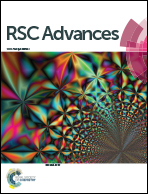Heterocyclic aminopyrazine–reduced graphene oxide coated carbon cloth electrode as an active bio-electrocatalyst for extracellular electron transfer in microbial fuel cells†
Abstract
In the present study, a low molecular heterocyclic aminopyrazine (Apy)–reduced graphene oxide (r-GO) hybrid coated carbon cloth (r-GO–Apy–CC) was employed as an active and stable bio-electro catalyst in a microbial fuel cell (MFC). The presence of imine (–NH–) and pyridinic (–N![[double bond, length as m-dash]](https://www.rsc.org/images/entities/char_e001.gif) C–) functional groups on the r-GO–Apy–CC electrode plays a critical role in the formation of bacterial colonization and enhanced extracellular electron transfer (EET) over a considerable period. The bacterial colonization over the r-GO–Apy–CC electrode was investigated in a Sacrificial Electrode Mode Reactor (SEMR) in which attached bacterial density with extracellular polysaccharides was monitored over a period. Simultaneously, cyclic voltammetry (CV) was performed in a bioelectrochemical system (BES) reactor, resulting in an increased current density–voltage response from 0.27 mA cm−2 to 1.84 mA cm−2 over a period of time. In addition, when r-GO–Apy–CC was employed as an anode in MFC, the power density was nearly two times (1253 mW m−2) than that of the MFC employed with plain carbon cloth (PCC) (663.7 mW m−2) at a steady state condition. It was proposed that the combined effect of Apy hybridized with nanostructured r-GO provides a large surface area for bacterial colonization. Moreover, the high bioelectrocatalytic activity was attributed to the low molecular nature of the Apy, which incorporated well into the EET pathway of the exoelectrogens by a redox mechanism.
C–) functional groups on the r-GO–Apy–CC electrode plays a critical role in the formation of bacterial colonization and enhanced extracellular electron transfer (EET) over a considerable period. The bacterial colonization over the r-GO–Apy–CC electrode was investigated in a Sacrificial Electrode Mode Reactor (SEMR) in which attached bacterial density with extracellular polysaccharides was monitored over a period. Simultaneously, cyclic voltammetry (CV) was performed in a bioelectrochemical system (BES) reactor, resulting in an increased current density–voltage response from 0.27 mA cm−2 to 1.84 mA cm−2 over a period of time. In addition, when r-GO–Apy–CC was employed as an anode in MFC, the power density was nearly two times (1253 mW m−2) than that of the MFC employed with plain carbon cloth (PCC) (663.7 mW m−2) at a steady state condition. It was proposed that the combined effect of Apy hybridized with nanostructured r-GO provides a large surface area for bacterial colonization. Moreover, the high bioelectrocatalytic activity was attributed to the low molecular nature of the Apy, which incorporated well into the EET pathway of the exoelectrogens by a redox mechanism.


 Please wait while we load your content...
Please wait while we load your content...